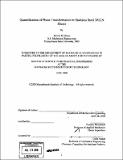Quantification of phase transformation in stainless steel 301LN sheets
Author(s)
Beese, Allison M
DownloadFull printable version (36.20Mb)
Other Contributors
Massachusetts Institute of Technology. Dept. of Mechanical Engineering.
Advisor
Tomasz Wierzbicki.
Terms of use
Metadata
Show full item recordAbstract
This thesis investigates the large deformation behavior of stainless steel 301LN cold-rolled sheets which is largely governed by the initial anisotropy combined with the phase transformation during deformation. Stainless steel offers high strength with relatively high ductility as compared with other structural steels. The effect of initial anisotropy on the strength in different material directions is studied in order to predict forming and crash response of vehicle components. It is observed that loading in the material rolling direction results in increased strength in the cross direction, however loading in the material cross-rolling direction results in decreased strength in the rolling direction. The mechanism responsible for the above cross-hardening is complex and requires investigation of the microstructural evolution of the sheets. The austenitic stainless steel studied is comprised of only austenite when in bulk form. However, the process of cold-rolling the bulk material into sheets results in strain-induced martensitic phase transformation. Additional straining of the material leads to even more transformation of austenite to martensite. Because martensite is a harder phase than austenite, micromechanical arguments suggest that the amount of martensite has an effect on the plasticity and eventual fracture of this material. In this thesis, the martensitic evolution as a function of material direction and strain level is measured using three different techniques: X-ray diffraction, microscopy, and magnetic induction. The first two methods require interrupted tests, while using a Feritscope allows for in-situ measurement of the martensite content. However, the Feritscope must be calibrated by another measurement method. (cont.) Observations of the measurements from each of the three methods confirm that the output of the Feritscope, Ferrite Number, is proportional to the martensite content. Therefore in-situ tests employing the Feritscope will allow for monitoring of the martensite content with evolution of stress and strain. From experiments described here, a directional dependence on martensite content is observed. The results from this study can be used to formulate an anisotropic martensite transformation kinetics law to describe the evolution of martensite content as a function of material anisotropy, stress state, and strain state.
Description
Thesis (S.M.)--Massachusetts Institute of Technology, Dept. of Mechanical Engineering, 2008. Includes bibliographical references (p. 101-102).
Date issued
2008Department
Massachusetts Institute of Technology. Department of Mechanical EngineeringPublisher
Massachusetts Institute of Technology
Keywords
Mechanical Engineering.